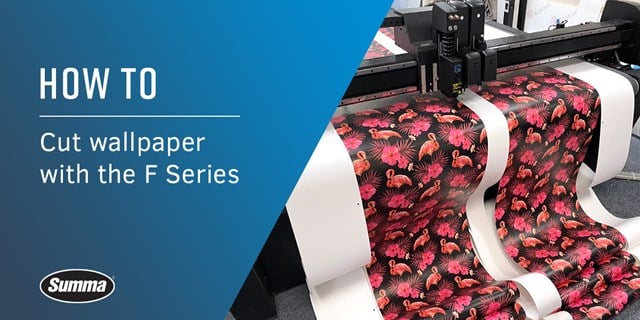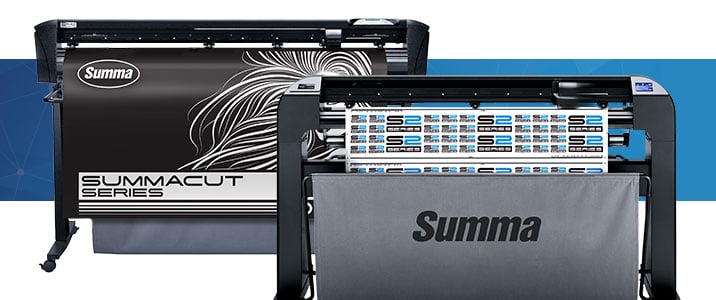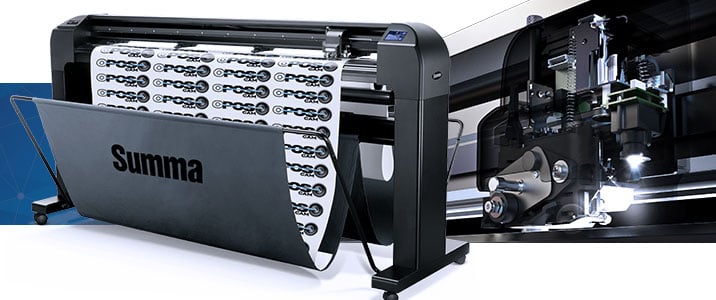Prior to the purchase of your vinyl cutter, certain specifications need to be considered, such as speed, pressure, repeatability and accuracy, to mention but a few. However, one thing, which is often overlooked, is the kind of technology your vinyl cutter uses to recognize marks on prints. In today’s market, you have a choice between camera-based and sensor-based optical recognition. People often tend to assume cameras are faster than sensors. Generally spoken, this is true. However, this is not the full story.
To avoid misunderstandings and to make sure you have a good overview, here is detailed information about both technologies.
Sensor-based recognition technology
First, we would like to start with sensor-based optical recognition, as this is one of the precursor technologies, used to determine positions. Many people think all sensors-based vinyl cutters work in similar ways. But this is not entirely correct.
Primarily, sensors measure a level of contrast for the material and a level of contrast for the ink. This measurement helps the firmware to determine the edge of a mark, as well as the size of the registration mark. Multiple marks can then be pinpointed on a sheet or roll, giving the firmware the necessary coordinates of the print itself and possible deformations.
Different types of sensors
In the current market, there are two possible types. The sensors themselves comprise different technologies.
The first type and one of the oldest around is the infrared sensor. It is capable of sensing accurately and quick enough to do the job. However, this type of sensor has its flaws. One of them is related to certain types of protective laminates, such as UV laminates. This type of substrate is designed to absorb or reflect UV light and infrared. Since the sensor uses infrared light to bounce off the measured surface, it tends to have difficulties recognizing any difference in contrast. Consequently, many of today’s finishing machines will have issues sensing the registration marks on these laminates.
Another issue with this type of sensor-based optical recognition could be the colour of the registration mark itself. Currently, the most often used colour of registration marks is red or hues of red.
However, the different shades of red could have a lower contrast because the infrared sensor will consider the red registration mark to be white. Consequently, red registration marks on white shades of material will not be sensed.
Before, Summa also used these sensors in their vinyl cutters, but we quickly realized its limitations would have an impact on future developments.
The sensor-based technology in a Summa vinyl cutter
Since then Summa has developed its bespoke sensor technology, based on a white-light sensor. This is the second type of sensor available in the market.
As a result of the white light technology, this sensor can detect a much wider range of colours. Moreover, issues with lamination, UV or otherwise, are reduced to an absolute minimum. One of the many benefits this technology offers is its capability to filter out any type of print-related issues, such as overspray or missing nozzles, without loss of accuracy during the final cut.
Nonetheless, even with the best intentions, the white-light sensor has its weaknesses. For instance, when measuring the values of the marks on highly mirroring media, the usage of this technology could get a bit tricky. It will measure the highly mirroring media as black, the same colour as the registration marks and will not sense any difference between them. In spite of that, Summa offers a cost-effective solution to this. By use of an additional physical yellow filter, the sensor can detect the registrations marks. The job will be done equally good, even on highly mirroring media.
SummaCut Series, S Class 2 Series - With sensor technology
Camera-based technology
This brings us to our second technology, the camera-based one, which is considered to be truly high-tech. It works in a very different way compared to the sensors. First, it takes a picture of the registration marks. Then, the accompanying software on the computer will analyze the picture.
This is necessary because the image needs to be translated towards data in terms of shape, size and position. It would be too heavy a job to perform this on the processing power of an integrated circuit within the machine. As the computer takes over all computational work, the machine itself is able to accurately and quickly go from one registration mark to another. All this results in a considerable increase in speed.
Adding to its speed, it is no longer necessary to move the head of the vinyl cutter back and forth on the mark for measurement. The camera simply goes to the registration mark and takes an image of it for the computer to process and moves directly to the next mark.
Speed is a significant benefit here, but it is by far not the only asset of the camera-based technology. Another one is the flexibility of having various imaging filters options within the software. This replaces the physical item as used in the sensor technology. The ease of use as to safeguarding the filter and the possibility to quickly change it are also important assets to this technology. This way, even difficult substrates, such as the mirror or reflective material, can be contour-cut easily and efficiently.
Increase your production outcome at a fraction
of the cost of a second flatbed cutter
And if you thought this is it, here’s another advantage. With the camera-based technology, you are no longer limited to use only one type of registration mark. With the right additional software, the vinyl cutter can recognize a multitude of shapes. Many types of Print&Cut workflows tend to use their own shape of registration mark. With the camera-based technology, your vinyl cutter can be part of the workflow without having to adapt anything.
Here’s an example. Assuming you have a flatbed cutter, which is constantly running, and your production need is growing steadily. Logically, you would add another flatbed cutter. However, Summa's camera-based vinyl cutter with specially developed software can detect the flatbed cutter's marks. Consequently, it is able
to reduce the flatbed cutter's burden of printed roll material, all at a fraction of the cost of a second flatbed cutter. If we piqued your interest in this particular workflow, simply check
Summa’s Twin workflow capabilities.
In fact, there is only one drawback to this technology. Unfortunately, it will not work on a Mac OS or Linux based operating system. You will still need to have a Windows-based system, connected to the machine to access the camera’s imagery for the analysis.
S Class 2 OPOS Cam Series - With camera technology
Exploding the myth
Before we end this explanatory article, there are some misunderstandings we would like to rectify as follows.
A common question or remark would be that a vinyl cutter with a camera could never be as accurate as one with a sensor or, vice versa. We can safely state that both systems are similar in terms of accuracy. As a matter of fact, our experts, testing this matter for years, have never encountered that one technology would be less accurate than the other.
Secondly, related to Summa's PostNET barcode automation workflow, some might say “Vinyl cutters with camera technology are not able to use this workflow”. This is simply no longer true, since the current S Class 2 OPOS CAM vinyl cutters are able to use this workflow. Only older S Class 1 OPOS CAM models wouldn’t support this workflow, but all newer models do.
So, we hope the above article has been of interest to you and helped you to better understand the differences between both technologies.
If you are convinced of the sensor-based technology,
we encourage you to take a look at the SummaCut series.
If the camera-based technology convinces you more
then the S Class 2 series is right up your alley.



